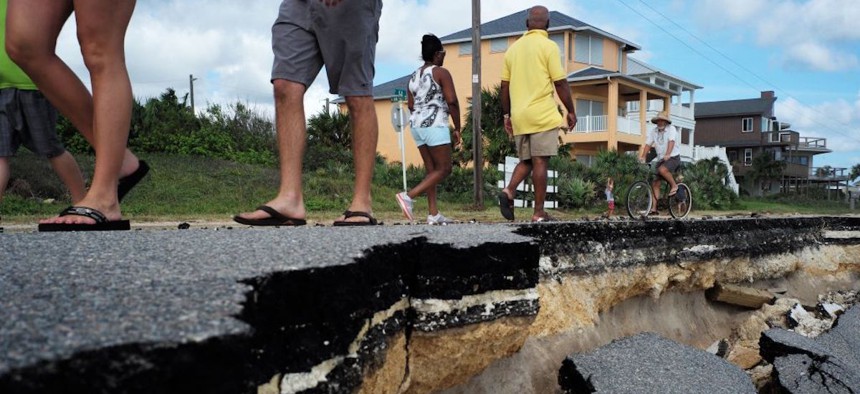Easier said than done: Tips for community relocation amid a changing climate

Local residents walk on a part of closed A1A highway washed out by Hurricane Matthew in Flagler Beach, Florida, on Oct. 9, 2016. JEWEL SAMAD/AFP via Getty Images
As eroding coasts and raging wildfires drive people from their homes, a new report offers guidance for community relocation programs.
Coastal communities are starting to say the quiet part out loud: What do we do if rising waters make it impossible to stay here?
Plan ahead, says the National Academies of Science, Engineering and Medicine, or NASEM, in a new report to help state and local agencies prepare for community relocation as a climate adaptation strategy.
Relocation is increasingly on the minds of state and local government officials grappling with environmental risks that will soon be too disruptive to ignore. Communities where a short drive to the beach was once a selling point, for instance, must now consider if it’s safe to stay there. Researchers estimate that the sea levels along the U.S. coastline could rise by up to 12 inches by 2050—an alarming progression considering that’s the same increase documented between 1920 and 2020.
However, it’s not just coastal properties that need to prepare. Communities further inland must plan for a growing number of climate migrants. That will mean more demand for essential services like housing, transportation, health care and schools, said Tracie Sempier, one of the report authors and co-chair of NASEM’s Committee on Managed Retreat in the U.S. Gulf Coast Region.
Out west, whole communities are facing such severe wildfire risks that they are leaning into planned relocation, said Mari Tye, a project scientist at the National Center for Atmospheric Research.
One way state and local governments can prepare for community relocation is with a land suitability analysis, she said. When evaluating potential relocation spots, agencies should consider if the land can support the required infrastructure development, such as installing new roads or integrating new power, water or sewer lines with the systems in the new location that people are moving to.
After Hurricane Matthew hit Princeville, North Carolina, in 2016, the state’s Division of Emergency Management, for example, conducted a land suitability analysis with local universities to identify potential relocation areas. They looked for places outside of the floodplain but still close to essential services like road and water infrastructure, schools and land suitable for home building. Collaboration among federal, state and local leaders and residents led to a preliminary plan for the partial relocation of Princeville’s critical facilities, new housing and essential services to a nearby 52-acre site, according to the NASEM report.
“Infrastructure tends to have a design life of 75 years, so if you’re putting something in the ground, you want to make sure you’ve designed it in a way that you don’t have to dig it up again in 10 to 15 years,” Tye said.
A land suitability analysis can also help agencies identify areas that should be prioritized for relocation, she said. Integrating data on the community’s climate, population and resident income can reveal, for example, areas where homes are at a high risk of flooding but where residents may be disproportionately burdened by the moving process without financial assistance.
“Think of it as planning your garden,” Tye said. “You know the areas that get a lot of sun [or have] different types of soil, so you know where it’s best to plant different types of vegetables. Take that up to the municipal level, and you’ve got areas that have been developed that are not going to be great for building parks or they’ve had a lot of pollution in the past. You don’t really want to put new housing there.”
In their relocation plans, officials should also consider amending or adopting rules on zoning, land acquisitions or open space management, the report said. For instance, policymakers can restrict future development in an area a community has moved from to prevent newer buildings from climate risks.
And policymakers can use insights from the land suitability analysis to enhance receiving communities by installing more green spaces and designing urban environments to be more walkable, according to the report.
Land-use planning also helps officials regulate how land can be developed or conserved for better climate and environmental outcomes during the relocation process.
Some communities in Louisiana, Tye said, are restoring coastal wetlands in high-risk areas, which can serve as natural buffers against natural disaster. Wetland vegetation, for instance, can soften flooding’s impact on nearby towns and cities and encourage biodiversity among plants and animals, which experts say are crucial to building climate resilience.
Governments must also consider how to reconfigure and redistribute essential services to meet the capacity and demand of an increased population in receiving communities, the report said. The Gulf Metropolitan Planning Organization, for example, is evaluating how it might adapt its transportation services to fit the needs of an expanded community, Sempier said. It is also assessing changes to roadways and bridges necessary to accommodate new infrastructure and housing developments.
Additionally, at-risk communities could take a hit in tax revenue as more residents relocate or home values fall. And because it’s prohibitively expensive to deliver community services to two locations, county-level governments or utility providers can consolidate “or identify suitable areas for resettlement in their existing jurisdiction,” according to the report.
To get a jump on relocation, some local governments are developing buyout programs to purchase homes and buildings from the original owners so that agencies can proactively prepare the area for climate adaptation. In Texas, the Harris County Flood Control District identifies priority areas for buyouts so that when the county receives state or federal grants, they can more quickly purchase the property, Sempier said.
Ultimately, state and local governments must plan ahead for community relocation in order to ensure long-term sustainability and viability of communities, she said.






